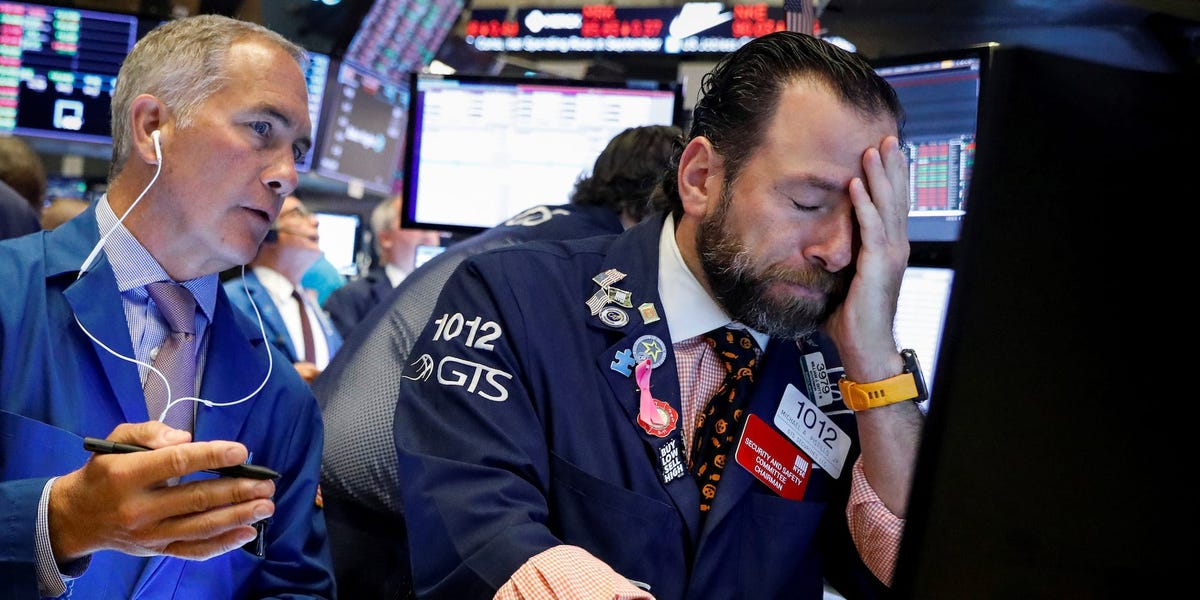It’s been a strong summer for stocks, but investors are about to enter what is historically the worst period of the year for the market.
The period from late July to mid-October is a tough stretch, with August and September often seeing the worst of the volatility.
The S&P 500 has dipped by an average 0.6% in August over the last 35 years, according to an analysis from the financial services firm StoneX.
That’s only slightly better than September, in which the S&P 500 has shed nearly 1% on average since 1990.
August and September have historically been losing months for the S&P 500.
Tradingview/StoneX
“August has historically been a month where stock market volatility rises,” the firm wrote in note, adding that the VIX, the stock market’s fear gauge, has climbed by an average eight percentage points during the month since 1990.
Concerns of a looming pullback have been creeping into sentiment on Wall Street, with more forecasters warning of a stock market correction in recent weeks.
Here’s what strategists think could be coming for the market, and how much they think stocks could drop in the coming months.
Evercore ISI: up to a 15% drop
Evercore ISI has one of the most bearish views among Wall Street firms. The investment bank’s research arm thinks the S&P 500 could be headed for as much as a 15% correction in the coming months. That implies the benchmark index falling to around 5,400 from its current level.
Related stories

Business Insider tells the innovative stories you want to know

Business Insider tells the innovative stories you want to know
In a recent note to clients, Julian Emanuel, the firm’s chief equity strategist, pointed to lofty valuations in stocks. Investors, meanwhile, could be getting overconfident and too wrapped up in the fear of missing out, he said, adding that his year-end target for the S&P 500 was 5,600.
“FOMO has begun,” Emanuel wrote. “Stocks have overdiscounted the potential for continued good news.”
Stifel: Up to a 14% drop
Raymond Boyd/Getty Images
Stifel said it saw the market dropping as much as 14% before the end of the year.
The firm said on Monday that valuations in the benchmark index look “very extended,” comparing the excitement for stocks to the euphoria at the peak of the dot-com bubble.
Stifel has also been warning of stagflation in the US economy, a dreaded scenario where inflation remains hot while growth slows. That situation is often thought of as even worse than a typical recession, as higher prices prevent the central bank from cutting interest rates to give the economy a lift.
“The lesson of history is that it is usually a sudden economic slowdown, which is what we forecast for 2H 2025. Slowdowns come in different forms and this one is stagflation, which is already noticeably slowing consumer spending,” strategists wrote.
Morgan Stanley: Up to 10% drop
Mike Wilson, Morgan Stanley’s chief investment officer, said he saw as much as a 10% correction coming for the benchmark index. That’s largely because the impact of tariffs will continue to flow through the economy and affect corporate earnings, he said, which could spark a modest pullback in the S&P 500.
“As we’ve been saying, the third quarter is probably the quarter of risk, where you’ll see some of this flow through to the cost of goods sold. I don’t think this is a massive correction,” Wilson told Bloomberg last month.
In a separate note in August, a team of strategists led by Wilson added that fears of hotter inflation in the US could cause the Fed to keep interest rates higher for longer, another factor that’s expected to be bearish for stocks.
Still, the bank remains optimistic about the market over the long term. Wilson said Morgan Stanley planned to buy any pullback in the market, thanks to an overarching bullish backdrop for stocks.
“I think the pullbacks will be short and shallow. Maybe there’ll be another surprise, another test of some kind that will be something more severe. But I really can’t see more than a 5%-10% correction,” he added.
Wells Fargo: Up to a 10% drop
Justin Sullivan/Getty Images
The S&P 500 dropping as much as 10% would be reasonable, according to Scott Wren, the chief market strategist at Wells Fargo.
Speaking to CNBC this week, Wren said he expected more volatility in the overall market, and pointed to several factors that could drive a decline in the benchmark index.
- Uncertainty stemming from President Donald Trump’s tariffs. Economists have said the full effect of tariffs has yet to be seen in the economic data. The deadline for the US-China trade deal has also been extended for another 90 days, meaning higher tariffs on China remain an unknown hanging over the market.
- Inflation is creeping higher. Consumer prices grew 2.7% in July, in-line with expectations, but the overall inflation rate remains higher than it was several months ago.
- Growth concerns. GDP came in at 3% for the second quarter, but growth for the first half of the year overall was weaker than levels seen in 2024.
“When you look back over the history, the long history of the S&P 500, you have a 10% pullback on average about every 10-and-a-half months,” Wren added. “If we saw 5-10%, 7-10% I think that’d be pretty reasonable after the run we’ve had.”
Wren said his year-end target for the S&P 500 was 6,400, implying that stocks would be about flat for the rest of the year.
